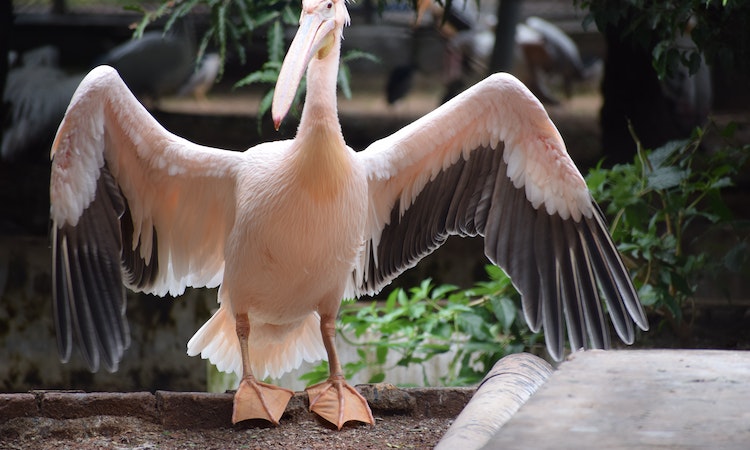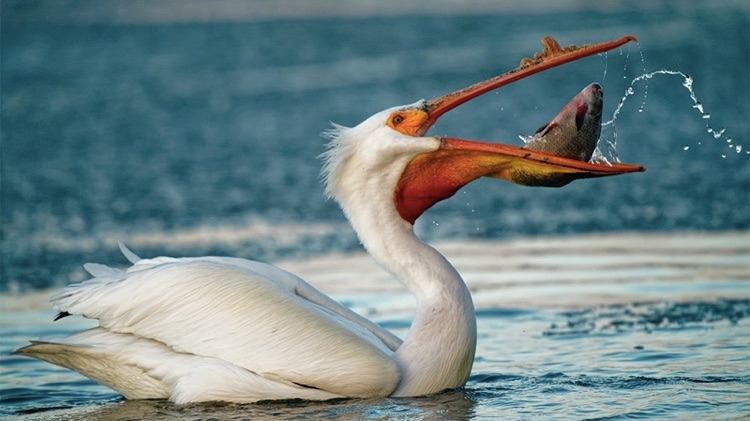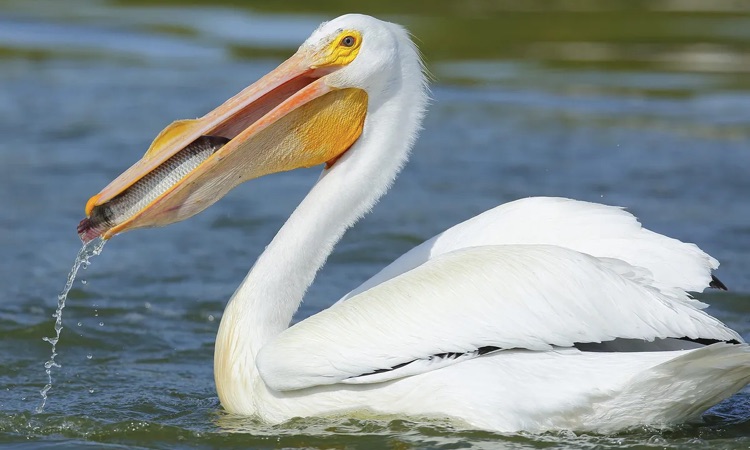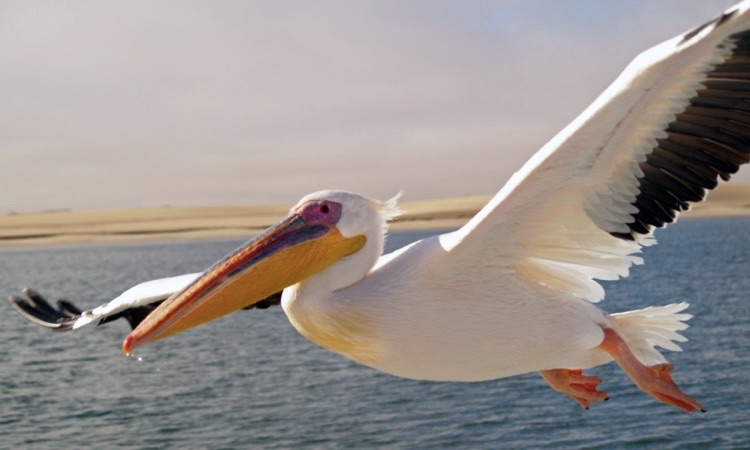Pelicans are grand aquatic birds well-known for their distinctive method of fishing using a pouch in the lower bill. Presently, there exist eight species spanning multiple regions across the globe.
Pelicans are no strangers to fame, from appearing in popular films like Finding Nemo to being the national bird of Romania and three Caribbean countries. Sports teams all over the world have even adopted pelicans as their mascots!
Now that we’ve discussed their celebrity status, let’s discover what these mesmerizing birds feed on. What do pelicans eat?

What do Pelicans Eat?
Pelicans primarily consume fish. However, when the situation calls for it they may also dine on amphibians, insects, birds and small mammals.
A pelican’s food source is solely meat, categorizing it as both a carnivore and predator in its natural habitat.
As consummate aquatic birds, pelicans acquire much of their sustenance from or near the sea. The size of prey they devour ranges greatly between species. Some will take fish at a mere few inches while others are capable of catching meals that span multiple feet in length.
Take pink-backed pelicans, for instance – they can consume fish that weigh up to a pound! On the other hand, great white pelicans are capable of swallowing much bigger prey, as large as 4.2 pounds!
Pelican diets vary from region to region, with menhaden, herring, sheepshead, pigfish, minnows and mullet being popular choices worldwide.
Meanwhile in coastal regions of the Pacific Ocean pelicans are especially fond of anchovies and sardines when it comes to their nutritional needs.
Pelicans are not only renowned for their fish consumption, but also feed on amphibians like frogs and salamanders, turtles, crustaceans including shrimp and crayfish, insects and interestingly enough, other birds. In fact, birds ended up being an enormous food source for several pelican species.
For instance, Great white pelicans have been witnessed gorging on pigeons in various parks across London. Moreover, Australian, Brown and Peruvian pelicans habitually devour fledglings in their own domains.

A Comprehensive List of Foods Pelicans Eat
Still wondering what do pelicans eat? A pelican diets consist of the following items:
- Mullet
- Minnows
- Crabs
- Turtles
- Lizards
- Anchovies
- Sardines
- Herring
- Pigfish
- Frogs
How do Pelicans Hunt?
Pelicans are remarkable hunters, with the incredible ability to capture prey that is much larger than what seems possible. To meet their daily requirement of 4 lbs of fish, a variety of hunting techniques have been observed in certain species. Now let’s take an up-close look at how these majestic birds find food!
Feeding in a Group
Pelicans have the unique ability to fish in both a collective and individual manner. When fishing together, they will mobilize shallow-water schools of fish into an enclosed area near the shoreline by fluttering their wings on top of the water’s surface. This method proves successful as it enables them to easily access their prey with ease.
Herding together, pelicans take turns soaring and seizing fish with their beaks. Certain species of them are even known to synchronize strategies with other kinds of birds for an even more effective fishing session.

Solitary Feeding
When feeding solitarily, they will spot fish in the water and swoop down to grab them. Larger fish need to be grabbed with the tips of their bills, allowing them to flip their catch into the air, catching it in their pouch.
The pelican is an incredible bird, capable of diving from a remarkable 70 feet up and plunging into the depths to catch fish in its pouch. After returning to the surface with their bounty, they expel any excess water by tipping their head back so that they can swallow it all whole.
From the water’s surface, pelicans use their pouch to readily capture meals. By plunging its beak into the liquid beneath them and scooping up unsuspecting fish, these birds then drain out any excess water from their prey before consumption.
And although some of this foraging takes place in mid-air dives, most is done on stable ground, or ocean floor!
Pelicans must constantly be on guard from other smaller seabirds who attempt to steal their food. These birds will often perch themselves atop the pelican’s head while they are draining water from their pouch and peck at them.
Then when the pelican turns to fight them off, they quickly swoop away with a small fish. Gulls in particular commonly execute this technique.
Do Pelicans Store Stuff in their Pouch?
Contrary to what popular culture may lead you to believe, pelicans do not use their iconic gular pouch as a storage device. In reality, they only utilize it for the purpose of catching small fish while in water – nothing more!
This myth has been perpetuated by movies and TV shows that depict these majestic birds using their pouches differently than intended.Yyet this could not be further from the truth.
Nevertheless, pelicans’ pouches are unbelievably colossal. Their beaks can reach up to 18 inches in length and make them the bird species with some of the most prominent bills. Interestingly, certain studies even suggest that a single pelican is capable of scooping an impressive three gallons of water into its throat pouch!
It’s an astounding achievement for a bird that typically weighs 11-20 pounds, to be able to carry up to 25 more in just three gallons of water. That doesn’t even take into account the potential weight of any fish they may have caught!

How do Baby Pelicans Eat?
The pelican has long been recognized as a symbol of self-sacrifice and perseverance during difficult times. Legend speaks of the bird cutting itself to feed its young in dire circumstances.
This is an image that resonated with many cultures throughout history. This belief serves as an important reminder for us all to keep striving even when faced with pain or hardship.
To combine their beliefs with Christian teachings, the Feast of Corpus Christi, Eucharist and Passion of Jesus were all represented by a pelican.
Although this isn’t scientifically accurate today, one can still spot evidence of these symbols in modern day heraldry from the Corpus Christi College in Oxford and Cambridge.
While not as romantic or symbolic as giving your own blood for the sake of offspring, many large bird species feed their young in a similar fashion.
Pelicans are no exception – they open their mouths and let the babies reach down into their throat to retrieve food. It’s an everyday occurrence that doesn’t lack its beauty and significance, nevertheless!
A Poem about Pelicans
Dixon Lanier Merritt composed a renowned limerick in 1910 that praised the skill of pelicans to capture copious amounts of fish in their pouches:
A wonderful bird is the pelican,
His bill will hold more than his belican,
He can take in his beak
Food enough for a week,
But I’m damned if I see how the helican


